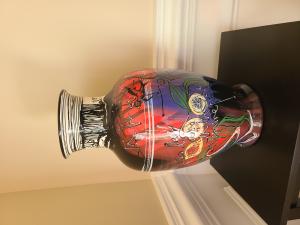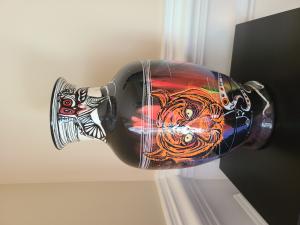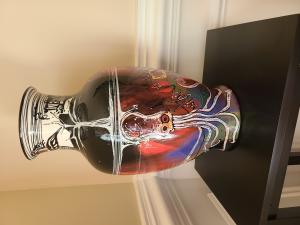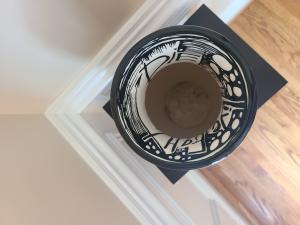Camus vase
Kaelyn Loes and John Groom
Ceramics
Camus quote - In the depth of winter I finally realized that within me lay an invincible summer
Inside - Live , Fight, Die
Inside - Live , Fight, Die
Albert Camus was a French philosopher, author, and journalist. He won the Nobel Prize in Literature at the age of 44 in 1957, the second-youngest recipient in history.
Camus was born in Algeria (a French colony at the time) to French Pieds Noirs parents. His citizenship was French. He spent his childhood in a poor neighborhood and later studied philosophy at the University of Algiers. He was in Paris when the Germans invaded France during World War II in 1940. Camus tried to flee but finally joined the French Resistance where he served as editor-in-chief at Combat, an outlawed newspaper. After the war, he was a celebrity figure and gave many lectures around the world. He married twice but had many extramarital affairs. Camus was politically active; he was part of the Left that opposed the Soviet Union because of its totalitarianism. Camus was a moralist and leaned towards anarcho-syndicalism. He was part of many organizations seeking European integration. During the Algerian War (1954 –1962), he kept a neutral stance, advocating for a multicultural and pluralistic Algeria, a position that caused controversy and was rejected by most parties.
Philosophically, Camus's views contributed to the rise of the philosophy known as absurdism. He is also considered to be an existentialist, even though he firmly rejected the term throughout his lifetime.
Philosophy
Existentialism
Even though Camus is mostly connected to Absurdism,[66] he is routinely categorized as an Existentialist, a term he rejected on several occasions.[67]
Camus himself said his philosophical origins lay in ancient Greek philosophy, Nietzsche, and 17th-century moralists whereas existentialism arises from 19th- and early 20th-century philosophy such as Kierkegaard, Karl Jaspers, and Heidegger.[68] He also said his work, The Myth of Sisyphus, was a criticism of various aspects of existentialism.[69] Camus was rejecting existentialism as a philosophy, but his critique was mostly focused on Sartrean existentialism, and to a lesser extent on religious existentialism. He thought that the importance of history held by Marx and Sartre was incompatible with his belief in human freedom.[70] David Sherman and others also suggest the rivalry between Sartre and Camus also played a part in his rejection of existentialism.[71] David Simpson argues further that his humanism and belief in human nature set him apart from the existentialist doctrine that existence precedes essence.[72]
On the other hand, Camus focused most of his philosophy around existential questions. The absurdity of life, the inevitable ending (death) is highlighted in his acts. His belief was that the absurd—life being void of meaning, or man's inability to know that meaning if it were to exist—was something that man should embrace. His anti-Christianity, his commitment to individual moral freedom and responsibility are only a few of the similarities with other existential writers.[73] More importantly, Camus addressed one of the fundamental questions of existentialism: the problem of suicide. He wrote: "There is only one really serious philosophical question, and that is suicide." Camus viewed the question of suicide as arising naturally as a solution to the absurdity of life.[42]
Absurdism
Many existentialist writers have addressed the Absurd, each with their own interpretation of what it is and what makes it important. Kierkegaard explains that the absurdity of religious truths prevents us from reaching God rationally.[74] Sartre recognizes the absurdity of individual experience. Camus's thoughts on the Absurd begins with his first cycle of books and the literary essay The Myth of Sisyphus, (Le Mythe de Sisyphe), his major work on the subject. In 1942 he published the story of a man living an absurd life in L'Étranger. He also wrote a play about the Roman emperor Caligula, pursuing an absurd logic, which was not performed until 1945. His early thoughts appeared in his first collection of essays, L'Envers et l'endroit (Betwixt and Between) in 1937. Absurd themes were expressed with more sophistication in his second collection of essays, Noces (Nuptials), in 1938 and Betwixt and Between. In these essays, Camus reflects on the experience of the Absurd.[75] Aspects of the notion of the Absurd can be found in The Plague.[76]
Camus follows Sartre's definition of the Absurd: "That which is meaningless. Thus man's existence is absurd because his contingency finds no external justification".[74] The Absurd is created because man, who is placed in an unintelligent universe, realises that human values are not founded on a solid external component; or as Camus himself explains, the Absurd is the result of the "confrontation between human need and the unreasonable silence of the world."[77] Even though absurdity is inescapable, Camus does not drift towards nihilism. But the realization of absurdity leads to the question: Why should someone continue to live? Suicide is an option that Camus firmly dismisses as the renunciation of human values and freedom. Rather, he proposes we accept that absurdity is a part of our lives and live with it.[78]
The turning point in Camus's attitude to the Absurd occurs in a collection of four letters to an anonymous German friend, written between July 1943 and July 1944. The first was published in the Revue Libre in 1943, the second in the Cahiers de Libération in 1944, and the third in the newspaper Libertés, in 1945. The four letters were published as Lettres à un ami allemand (Letters to a German Friend) in 1945, and were included in the collection Resistance, Rebellion, and Death.
Camus regretted the continued reference to himself as a "philosopher of the absurd". He showed less interest in the Absurd shortly after publishing Le Mythe de Sisyphe. To distinguish his ideas, scholars sometimes refer to the Paradox of the Absurd, when referring to "Camus's Absurd".[79]
Revolt
Camus is known for articulating the case for revolting against any kind of oppression, injustice, or whatever disrespects the human condition. He is cautious enough, however, to set the limits on the rebellion.[80] L'Homme révolté (The Rebel) explains in detail his thoughts on the issue. There, he builds upon the absurd (described in The Myth of Sisyphus) but goes further. In the introduction, where he examines the metaphysics of rebellion, he concludes with the phrase "I revolt, therefore we exist" implying the recognition of a common human condition.[81] Camus also delineates the difference between revolution and rebellion and notices that history has shown that the rebel's revolution might easily end up as an oppressive regime. So he places importance on the morals accompanying the revolution.[82] Camus poses a crucial question: Is it possible for humans to act in an ethical and meaningful manner, in a silent universe? According to him the answer is yes, as the experience and awareness of the Absurd creates the moral values and also sets the limits of our actions.[83] Camus separates the modern form of rebellion into two modes. First, there is the metaphysical rebellion, which is "the movement by which man protests against his condition and against the whole of creation." The other mode, historical rebellion, is the attempt to materialize the abstract spirit of metaphysical rebellion and change the world. In this attempt, the rebel must balance between the evil of the world and the intrinsic evil which every revolt carries, and not cause any unjustifiable suffering.[84]
Legacy
Camus's novels and philosophical essays are still influential. After his death, interest in Camus followed the rise (and diminution) of the New Left. Following the collapse of Soviet Union, interest in his alternative road to communism resurfaced.[85] He is remembered for his skeptical humanism and his support for political tolerance, dialogue, and civil rights.[86]
Although Camus has been linked to anti-Soviet communism, reaching as far as anarcho-syndicalism, some neo-liberals have tried to associate him with their policies, e.g. when the French President Nicolas Sarkozy suggested that his remains to be moved to the Panthéon, an idea that angered many on the Left.[87]
Camus was born in Algeria (a French colony at the time) to French Pieds Noirs parents. His citizenship was French. He spent his childhood in a poor neighborhood and later studied philosophy at the University of Algiers. He was in Paris when the Germans invaded France during World War II in 1940. Camus tried to flee but finally joined the French Resistance where he served as editor-in-chief at Combat, an outlawed newspaper. After the war, he was a celebrity figure and gave many lectures around the world. He married twice but had many extramarital affairs. Camus was politically active; he was part of the Left that opposed the Soviet Union because of its totalitarianism. Camus was a moralist and leaned towards anarcho-syndicalism. He was part of many organizations seeking European integration. During the Algerian War (1954 –1962), he kept a neutral stance, advocating for a multicultural and pluralistic Algeria, a position that caused controversy and was rejected by most parties.
Philosophically, Camus's views contributed to the rise of the philosophy known as absurdism. He is also considered to be an existentialist, even though he firmly rejected the term throughout his lifetime.
Philosophy
Existentialism
Even though Camus is mostly connected to Absurdism,[66] he is routinely categorized as an Existentialist, a term he rejected on several occasions.[67]
Camus himself said his philosophical origins lay in ancient Greek philosophy, Nietzsche, and 17th-century moralists whereas existentialism arises from 19th- and early 20th-century philosophy such as Kierkegaard, Karl Jaspers, and Heidegger.[68] He also said his work, The Myth of Sisyphus, was a criticism of various aspects of existentialism.[69] Camus was rejecting existentialism as a philosophy, but his critique was mostly focused on Sartrean existentialism, and to a lesser extent on religious existentialism. He thought that the importance of history held by Marx and Sartre was incompatible with his belief in human freedom.[70] David Sherman and others also suggest the rivalry between Sartre and Camus also played a part in his rejection of existentialism.[71] David Simpson argues further that his humanism and belief in human nature set him apart from the existentialist doctrine that existence precedes essence.[72]
On the other hand, Camus focused most of his philosophy around existential questions. The absurdity of life, the inevitable ending (death) is highlighted in his acts. His belief was that the absurd—life being void of meaning, or man's inability to know that meaning if it were to exist—was something that man should embrace. His anti-Christianity, his commitment to individual moral freedom and responsibility are only a few of the similarities with other existential writers.[73] More importantly, Camus addressed one of the fundamental questions of existentialism: the problem of suicide. He wrote: "There is only one really serious philosophical question, and that is suicide." Camus viewed the question of suicide as arising naturally as a solution to the absurdity of life.[42]
Absurdism
Many existentialist writers have addressed the Absurd, each with their own interpretation of what it is and what makes it important. Kierkegaard explains that the absurdity of religious truths prevents us from reaching God rationally.[74] Sartre recognizes the absurdity of individual experience. Camus's thoughts on the Absurd begins with his first cycle of books and the literary essay The Myth of Sisyphus, (Le Mythe de Sisyphe), his major work on the subject. In 1942 he published the story of a man living an absurd life in L'Étranger. He also wrote a play about the Roman emperor Caligula, pursuing an absurd logic, which was not performed until 1945. His early thoughts appeared in his first collection of essays, L'Envers et l'endroit (Betwixt and Between) in 1937. Absurd themes were expressed with more sophistication in his second collection of essays, Noces (Nuptials), in 1938 and Betwixt and Between. In these essays, Camus reflects on the experience of the Absurd.[75] Aspects of the notion of the Absurd can be found in The Plague.[76]
Camus follows Sartre's definition of the Absurd: "That which is meaningless. Thus man's existence is absurd because his contingency finds no external justification".[74] The Absurd is created because man, who is placed in an unintelligent universe, realises that human values are not founded on a solid external component; or as Camus himself explains, the Absurd is the result of the "confrontation between human need and the unreasonable silence of the world."[77] Even though absurdity is inescapable, Camus does not drift towards nihilism. But the realization of absurdity leads to the question: Why should someone continue to live? Suicide is an option that Camus firmly dismisses as the renunciation of human values and freedom. Rather, he proposes we accept that absurdity is a part of our lives and live with it.[78]
The turning point in Camus's attitude to the Absurd occurs in a collection of four letters to an anonymous German friend, written between July 1943 and July 1944. The first was published in the Revue Libre in 1943, the second in the Cahiers de Libération in 1944, and the third in the newspaper Libertés, in 1945. The four letters were published as Lettres à un ami allemand (Letters to a German Friend) in 1945, and were included in the collection Resistance, Rebellion, and Death.
Camus regretted the continued reference to himself as a "philosopher of the absurd". He showed less interest in the Absurd shortly after publishing Le Mythe de Sisyphe. To distinguish his ideas, scholars sometimes refer to the Paradox of the Absurd, when referring to "Camus's Absurd".[79]
Revolt
Camus is known for articulating the case for revolting against any kind of oppression, injustice, or whatever disrespects the human condition. He is cautious enough, however, to set the limits on the rebellion.[80] L'Homme révolté (The Rebel) explains in detail his thoughts on the issue. There, he builds upon the absurd (described in The Myth of Sisyphus) but goes further. In the introduction, where he examines the metaphysics of rebellion, he concludes with the phrase "I revolt, therefore we exist" implying the recognition of a common human condition.[81] Camus also delineates the difference between revolution and rebellion and notices that history has shown that the rebel's revolution might easily end up as an oppressive regime. So he places importance on the morals accompanying the revolution.[82] Camus poses a crucial question: Is it possible for humans to act in an ethical and meaningful manner, in a silent universe? According to him the answer is yes, as the experience and awareness of the Absurd creates the moral values and also sets the limits of our actions.[83] Camus separates the modern form of rebellion into two modes. First, there is the metaphysical rebellion, which is "the movement by which man protests against his condition and against the whole of creation." The other mode, historical rebellion, is the attempt to materialize the abstract spirit of metaphysical rebellion and change the world. In this attempt, the rebel must balance between the evil of the world and the intrinsic evil which every revolt carries, and not cause any unjustifiable suffering.[84]
Legacy
Camus's novels and philosophical essays are still influential. After his death, interest in Camus followed the rise (and diminution) of the New Left. Following the collapse of Soviet Union, interest in his alternative road to communism resurfaced.[85] He is remembered for his skeptical humanism and his support for political tolerance, dialogue, and civil rights.[86]
Although Camus has been linked to anti-Soviet communism, reaching as far as anarcho-syndicalism, some neo-liberals have tried to associate him with their policies, e.g. when the French President Nicolas Sarkozy suggested that his remains to be moved to the Panthéon, an idea that angered many on the Left.[87]
Height: 16.5
Width: 9
Depth: 9
inches
Phoenix, AZ
Clay sculpted to Vase with wheel,
hand painted and hand clear coat glaze before firing.
Glaze inside and out
https://www.linkedin.com/in/kaelynloes






